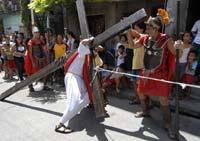Gory ritual marks penitence of Catholic followers

The final moments in the life of Jesus Christ are observed in ritual imitation each year in the Philippines – down to the most painfully precise detail.
While in BC, families observe the religious holiday through family meals and prayer, back home in the Philippines the remembrance takes on a more gory aspect.
In places like Angeles City, hundreds of Filipinos march on roads, carrying heavy wooden crosses and whipping their backs until they bleed in an annual religious ritual as the mainly Catholic Philippines observed near the end of Lent.
A few of the extremely brave and devout, step forward for voluntary crucifixion.
Nine men wearing crowns of twigs on their heads were crucified for a few minutes by villagers dressed as Roman centurions in northern Pampanga province’s San Pedro Cutud village. At least eight other people were nailed to crosses in neighboring villages.
The spectacle reflects a unique brand of Catholicism that merges church traditions with Philippine folk superstitions.
Many of the mostly impoverished penitents undergo the ritual to atone for sins, pray for the sick or a better life, or give thanks for what they believe were God-given miracles.
Friday’s crucifixion was the 26th for Ruben Enaje, a 51-year-old sign painter. He began his yearly rite after surviving a fall from a building.
Hours after his palms and feet were nailed to a cross, Enaje, a grandfather of four, said he felt fine and had already walked to the village captain’s house.
“I feel good because my suffering has ended,” he said.
Prior to the crucifixions, dozens of male penitents walked several kilometers (miles) through village streets, beating their bare backs with sharp bamboo sticks and pieces of wood. Some of the penitents had their backs inflicted with cuts to keep them bloody.
“We do not judge and condemn, but we discourage it,” Archbishop Jose Palma, president of the Catholic Bishops Conference of the Philippines, said of the crucifixions.
The Rev. Melvin Castro, also of the CBCP, said “the church’s position is there’s no need to go through this physical and literal pain on the body because Christ already did that for us.”
He said what the church asks is for people to “enter into the passion and death of Christ by internal sacrifices,” including going to confession and giving alms.
Many Filipino devotees perform religious penance during the week leading up to Easter Sunday as a form of worship and supplication, a practice discouraged by Catholic bishops, but widely believed by devotees to cleanse sins, cure illness and even grant wishes.
“I do this penance out of my free will because I believe that God will help relieve my sickness,” Corazon Cabigting, a domestic helper and the only woman in a group of about 50 men carrying wooden crosses on their backs.
The annual display is attracting increasing numbers of curious tourists to observe.
One Canadian tourist, Samantha Todd, said the crucifixions touched her.
“Even though it’s not my faith, it makes me feel something inside,” she said.
Foreigners have been banned from taking part since an Australian comic was nailed to a cross under a false name a few years ago near Pampanga. Authorities also believe that a Japanese man sought to be crucified as part of a porn film in 1996.
Like the men, Cabigting wore a maroon robe and covered her face with a veil, held on her head by a crown of stainless wire, dragging a 30-kg (66-lb) wooden cross and stopping every 500 meters (546 yards) in makeshift roadside chapels.
Elderly women chant the passion of Jesus Christ at some of the chapels, while the penitents, with their hands tied to the cross, are beaten by sticks and hemp.
Bloody gashes from repeated strikes of whips could be seen on the backs of devotees as they walked barefoot along the streets, believing that their sacrifice will somehow grant salvation.
Leave a comment









